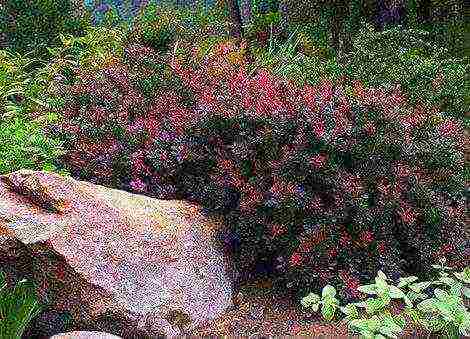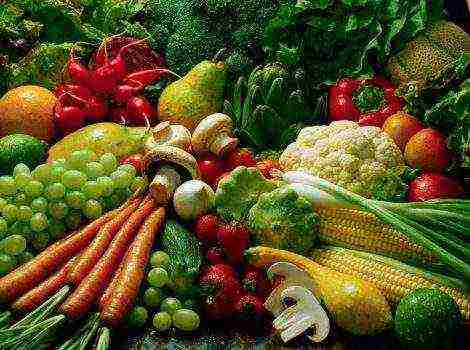Content
- 0.1 How to choose a seat
- 0.2 Soil for tulips
- 0.3 Flower bed preparation
- 0.4 Dates of planting tulips in open ground
- 0.5 First feeding of tulips
- 0.6 Second feeding
- 0.7 Third feeding
- 0.8 How often to replant tulips to a new place
- 0.9 What to do with the bulbs after digging
- 0.10 Gray rot (lat.Botrytis tulipae)
- 0.11 Root rot (lat.Ruthium)
- 0.12 Tulip variegation
- 1 Outcome
- 2 Types and varieties of tulips
- 3 Planting tulips
- 4 Tulip care
- 5 Reproduction
- 6 Diseases and pests
- 7 How to store bulbs
- 8 Features of growing tulips in the open field
- 9 Choosing bulbs for planting
- 10 Time and timing of planting tulips
- 11 How to plant tulips correctly?
- 12 Tulip care
- 13 Features of care after flowering
- 14 Protection against diseases and pests
Tulips - growing in the open field Choosing a planting material: what to look for
When buying tulip bulbs, you should pay attention to their size. You should not choose large planting material: most likely, it is old and will not delight you with abundant flowering. It is recommended to choose medium-sized bulbs with a smooth, shiny, scaly coating. Pay attention that there are no cracks on their surface - through them infections are transmitted and pests penetrate.
Pay attention to the color of the bulbs when purchasing
The color of the planting material should be golden tea color. Dark brown scales indicate that it was late dug out of the soil and may be damaged.
In a healthy bulb, the tip of the stem is slightly visible; but do not make a purchase if it sprouted during storage. The bottom and tubercles of the roots should be dry and firm. The healthy bulb is firm to the touch, without feeling watery or dry.
Healthy tulip bulbs Preparing and planting tulips outdoors
The key to the good development of tulips is a correctly selected and well-prepared place for a flower garden, as well as adherence to the timing of planting bulbs.
How to choose a seat
Tulips feel very good, which are grown in a sunny and sheltered flower bed. This can be an area under the crowns of trees - since the flowers bloom earlier than the leaves on the branches, the shade from them will not interfere.
Change the place of the flower garden for bulbous
Tulips should not be planted where bulbs were previously grown. The earth should "rest" from tulips for at least three years.
Soil for tulips
The soil for the successful flowering of tulips must be light, breathable. In the soil rich in loam, sand should be added at the rate of 2 buckets per 1 sq. m of the ridge.
If the site has a high level of groundwater, which is detrimental to flower bulbs, you should "raise" the flower bed (make it bulk and increase the soil layer) for tulips, or organize high-quality drainage under the flower bed. For protection from high humidity, leaching of nutrients and fertilizers from the soil, as well as for ease of transportation for storage, flowers are planted in a special container - plastic modules.
Planting tulips in a plastic module
Flower bed preparation
Before planting tulips, the ground is dug up, removing weeds and plant roots. Next, planting furrows are carried out, with a depth equal to three sizes of the bulbs.
Scheme: planting depth from the size of tulip bulbs
The bottom of the furrow is covered with a thin layer of river sand, on which the bulbs are placed at a distance of 10 cm from each other.
Planting tulips in a sandy furrow
Do not submerge the bulbs when planting.
The main mistake gardeners make when planting tulips is burying the bulbs. Usually they are pressed into the ground with your hands, but this cannot be done. The bulbs laid in the furrows are carefully sprinkled with earth and watered with water with the addition of several crystals of potassium permanganate for disinfection.
Dates of planting tulips in open ground
Early or mid-autumn is the best time to plant tulips when the outside temperature drops to 8-10 degrees Celsius. Planting in warmer soil leads to poor root development, and the bulbs are at risk of Fusarium disease. Tulips, which are planted in frost conditions, do not have time to take root before the onset of frost and may die.
Fertilizing and caring for tulips
Tulips, planting and caring for which will not cause much trouble, will delight you with bright and beautiful flowering, if fertilized in a timely manner.
First feeding of tulips
The first fertilizer is applied immediately after the appearance of green shoots. It is prepared by mixing 30 grams of nitrogen, 30 grams of phosphorus and 20 grams of potash fertilizers per 10 liters of water. The plantings are abundantly watered with this composition.
The first sprouts of tulips appear in early spring.
Second feeding
It is carried out before the flowering of tulips, when the greenish flower buds are formed. The composition of the top dressing: 20 grams of nitrogen, 20 grams of potash, 30 grams of phosphorus fertilizers per bucket of water.
Third feeding
Required after flowering to replenish nutrients: 30 grams of phosphorus and 20 grams of potassium fertilizers per bucket of water.
Tulips: care after flowering outdoors
After flowering, it is necessary to remove the seed capsule so that the plant does not waste energy on ripening the seeds, but stores them in the bulb for the next season. After the leaves begin to turn yellow and the stem loses its elasticity and becomes soft, you can start digging out the bulbs.
Digging out tulips - care after flowering in the open field
How often to replant tulips to a new place
Each gardener determines the frequency of replanting tulips to a new place for himself. You can dig up the bulbs annually, or do it every 2-3 years. It should be borne in mind that in the absence of a transplant, the flowers begin to grow worse and become smaller, since the content of nutrients in the soil decreases. That is why it is recommended to replant valuable varietal specimens annually.
What to do with the bulbs after digging
The dug out bulbs are washed in water and soaked for half an hour in a fungicide solution. In large bulbs, babies are separated if they have not disintegrated themselves. Then the planting material must be dried in the shade for several days, spreading a rag. After drying, the bulbs are stored in baskets or boxes and stored in a cool room until planting in the fall.
Storage option for tulip bulbs Major diseases and pests of tulips
Tulip diseases are spread with infected seed or bulbs. Therefore, please choose them carefully before purchasing.
Gray rot (lat.Botrytis tulipae)
It is found in plants grown in soils with an excess of moisture. May spread during rainy summers or over-watering. The growth of the flower slows down, its green parts become soft and watery.
Gray mold of tulips
Affected bulbs and flowers must be destroyed and cannot be treated. For prophylaxis purposes, the soil is powdered with sulfur before planting, and after planting it is sprayed with a 1% solution of Bordeaux liquid.
Root rot (lat.Ruthium)
It is easy to confuse the symptoms of the disease with the symptoms of insufficient watering: the green mass of the flower withers, becomes yellow or brown in color. Brown spots appear on the bulbs, it becomes soft to the touch and smells unpleasant.
Root rot of tulip bulbs
This can be caused by moisture stagnation caused by poor drainage. A diseased plant must be destroyed. For the purpose of prevention, they increase the aeration and water permeability of the soil during planting, mixing it with sand and draining it, or they organize raised ridges.
Tulip variegation
A dangerous disease caused by the tobacco mosaic virus (Latin Tobacco mosaic virus). It is transmitted through the planting material, the pruning tool, as well as by ticks and other sucking insects.
On the colored petals of flowers, light strokes appear in chaotic directions, the shape of the flower may be distorted. Signs are poorly visible on light tulip varieties.
Prevention of the disease is difficult due to the long latency period of the disease, which can develop over several years after infection. Prevention: treatment of plants with preparations from sucking pests; disinfection of bulbs before planting; sparse landing and constant examination in order to detect signs of disease.
Infected plants should be removed from the flower bed by gently pulling them out from the roots. The soil is preliminarily loosened around the bulb so that some of the roots do not remain in the soil and do not cause the spread of the disease.
Tulips: growing and care in Siberia, beyond the Urals, in the North
In the northern regions of Russia, it is quite possible to grow tulips, the care of which contains some features related to climatic conditions.
Due to early autumn frosts, planting of bulbs should be carried out no later than the second decade of September, at a temperature not lower than minus 2-3 degrees Celsius. The depth of the trench for planting the bulbs, regardless of their size, should be approximately 25 cm.
If the depth is less, the rhizomes may freeze out, and with a deeper planting, the plants will take a lot of energy to germinate and the tulip will bloom poorly. After placing the planting material, the ridge should be sprinkled with mature compost. It is recommended to collect the first snow from the surrounding area in a flower bed for additional protection from frost.
In spring, during flowering, snowfalls and frosts are also possible, so the longer the snow lies on the flower beds, the better. To retain it, instead of compost, you can use vegetable tops, straw, hay for snow retention.
Snow retention is important for tulip cultivation in Siberia
In the conditions of unstable summers and harsh winters, tulips bloom well, which are transplanted annually. Otherwise, the bulbs become smaller, are affected by pests and may die.
The following tulip varieties are well suited for cold regions: Bonanza, Dante, Brilliant Star, Christmas Marvel, Brilliant Star.
Brilliant Star tulips
Outcome
Gorgeous brightly colored tulips will brighten up your garden in early spring when the rest of nature is still awake. You just need to worry about planting the bulbs in the fall and take care of the plants in a timely manner - then you will have no trouble with tulips, except for admiring the colorful buds.
One of the main requirements of rational tulip farming is a periodic crop change. Neglect of this rule creates the danger of severe depletion of the soil, the spread of diseases and pests, contamination by weeds and bulbs left after harvesting. Tulips should be returned to their old place no earlier than after 3-4 years.
Site selection and preparation. Tulips prefer well-lit and drained areas, sheltered from the prevailing northeasterly winds, which cause premature fall of petals. Late varieties bloom longer in partial shade.
Tulips grow well on sandy loam, humus-rich neutral or slightly alkaline soils and do not tolerate sour.
Too light sandy soils are improved by the introduction of manure, humus, compost, sod land or sowing plants on green fertilizer.River sand, humus (granite) or green fertilizers are poured into heavy clay soils. In addition, before planting, sand is poured into the bottom of the furrow in a layer of about 2 cm.
In no case should fresh manure be introduced (!!!); applying it before planting, even in small quantities, leads to decay of the roots of tulips. Fresh manure can be applied 3 years before planting at the rate of 20-30 kg / sq. m. If it was not brought under the previous crops, under the main plowing or digging, it is advisable to add humus and phosphate rock (for 10 sq. m. 40-60 kg of humus and 8 kg of bone or phosphate rock). A very good fertilizer is properly prepared compost, which is needed for 10 square meters. m 90-120 kg. Before use, the compost is pickled with formalin, bleach, granosan, NIUIF-1 or steamed.
The main fertilizer promotes better reproduction and enlargement (enlargement) of flowers and bulbs due to the development of a more powerful root system. When applying the main fertilizer, autumn watering is required.
On garden plots 1.5-2 months before planting: it is good to add bulbs per 10 square meters. m 6-8 kg of humus, 60 g of superphosphate and 30 g of potassium salt and ammonium nitrate.
1.5-2 months before planting, the soil is dug to a depth of at least 25-30 cm, and 15-20 days before planting, it is dug again to a depth of 18-20 cm and then harrowed. In places where stagnation of melt and rainwater is possible, soil is poured.
All work on soil preparation is completed 6-8 days before planting the bulbs in order to avoid rupture of the roots when it settles.
Planting and leaving... The timing of planting bulbs is determined by the characteristics of the place where they are grown. It is known that a lower soil temperature (5-7 ° C) is required for the rooting of bulbs. In the middle lane, similar conditions are created in the first half of October. Almost all of October here is the most favorable time for planting.
The roots of tulips develop well at soil temperatures of 6-10 ° C. A higher temperature is harmful to them, and at 3 ° C the bulbs do not take root. Thus, it is not advisable to plant tulips later than the second half of October: the plants are more easily affected by the disease, and in the spring they are late with flowering. Before the soil freezes (October-November), the bulbs develop a powerful root system, which ensures their successful overwintering.
In the conditions of the Moscow region, taking into account the constant warm autumn, the optimal time for planting tulips is from September 20 to October 10. An earlier planting is not recommended, as bulbs often sprout during a prolonged autumn. However, they should root well before the onset of cold weather, so planting should be completed 3-4 weeks before frost. Tulips require 30-45 days to develop roots. Well-rooted bulbs easily tolerate unfavorable winters without additional shelter, poorly rooted ones require mandatory shelter for the winter.
Before planting, you need to look at each bulb and remove diseased and badly damaged ones.
Planting depth - the distance from the bottom of the bulb to the soil surface - is determined by the size of the bulb: the larger it is, the deeper it is planted. Small bulbs are planted to a depth of 6-8 cm, large ones - 12-14 cm, but not deeper than 15 cm.
It should be remembered that with excessive depth of the bulbs, the amount of formed babies decreases. In addition, tulips develop stolons - deepening roots that pull the bulb inward.
The distance between the bulbs depends on their size and the purpose of the planting. In nurseries, they are usually planted after 8-10 cm (small - after 1.5-2 cm). In small areas, grooves are cut at a distance of 20 cm from one another and the bulbs are manually laid out every 10-20 cm.
Rooting of the bulbs begins 10-15 days after planting. The rooting rate depends on weather conditions, primarily on the moisture and temperature of the soil.The best rooting is facilitated by mulching the soil after planting with a humus layer of 5-7 cm, due to which the soil does not freeze and the roots of tulips continue to develop longer, until severe frosts. In the spring, humus embedded in the soil serves as an additional fertilizer.
Tulips are quite demanding on moisture and soil fertility. To get large flowers and good bulbs, you need to create optimal conditions for the plants - give them enough moisture and nutrients.
Since the root system of bulbous flowering plants consists of short fibrous roots without root hairs and is able to absorb moisture only in the immediate vicinity, great importance is attached to irrigation. Moisture is especially needed from budding to flowering. Tulips should be watered so as to maintain soil moisture at 80% of field moisture capacity.
With an increase in soil moisture, especially after flowering, the bottom of the bulb cracks, which negatively affects its marketability and preservation. In addition, excess moisture creates favorable conditions for the spread of diseases. At the same time, a drop in soil moisture up to 30% of the field moisture capacity has a depressing effect on plants, which ultimately negatively affects the yield of bulbs.
The usual irrigation rate for sprinkling is 200-400 cubic meters. m / ha, and with furrow irrigation - 600-700. This suggests that during the growing season, tulips need to be watered, but not to bring the soil to waterlogging. Even in arid regions, water should be no more than three times per growing season.
For quick assimilation of nutrients and exclusion of plant burns, all types of fertilizing should be carried out in moist soil, after rains or watering. Fertilizers are often used with irrigation water. In the first top dressing, which is carried out in early spring after the snow melts or when sprouts appear, they are applied at the rate of 10 square meters. m 120-180 g of ammonium nitrate and 120-200 g of superphosphate. In this top dressing, you can give a complete granular fertilizer - nitrophoska (200 g per 10 sq. M).
Fertilizers are sown in the aisles or in grooves, followed by embedding to a depth of 12-15 cm. If superphosphate was introduced in the fall, then in the spring only nitrogen fertilizers are sufficient, at the rate of 250 g of ammonium nitrate per 10 sq. m. Urea (15% of the active substance), ammonium sulfate (20-25% of the active substance) or nitrophosphate are also used as nitrogen fertilizers.
The specificity of arid conditions, when under the influence of high temperatures and lack of moisture in plants, the phosphorus content drops sharply, necessitates foliar dressing with phosphorus fertilizer. Phosphorus, introduced through the leaves, is actively involved in metabolic processes, while with soil fertilization, part of it passes into a form inaccessible to plants.
The second top dressing with a predominance of superphosphate is given during the budding period, based on superphosphate 350 g, potassium salt 100-150 g and ammonium nitrate 90-120 g. At the end of flowering, add potassium salt and superphosphate (150-200 g per 10 sq. M ), 60-90 g of ammonium nitrate, in addition, it is good to add 300-400 g of ash.
Plants are processed using any spray equipment with a double superphosphate extract, diluted 1:10. Such feeding has a positive effect on increasing the total yield of bulbs.
Organic fertilizers can also be used as spring dressings - bird droppings, slurry, mullein. They are placed in vats, diluted with water and left to ferment. After 20 days, this solution is diluted 10 times, and one bucket (10 l) is poured into 2 square meters. m of wet earth.
In an arid zone, the successful cultivation of bulbs depends mainly on the use of measures that reduce the harmful effects of drought. The water-holding capacity of plants is increased by foliar feeding with microelements - boron and zinc.
Boron and zinc have a positive effect not only on the number of flowers, but also contribute to an increase in the percentage of large, full-bodied bulbs suitable for forcing. Boric acid (10 mg per 100 ml) and zinc sulfate (30 mg per 100 ml), which dissolve well in water and quickly penetrate into plant tissues, are recommended as boric and zinc microfertilizers. The consumption rate of the solution is 0.5 liters per 10 sq. m. It is best to process plants in the budding and flowering phase, since physiological and biological processes are activated during this period.
In soils where readily soluble forms of zinc are contained in sufficient quantities (from 0.32 to 0.95 mg per 1 kg of soil), spraying with Inca salts is ineffective. Boron treatment always gives positive results.
Solutions of boron and zinc salts must be prepared separately and sprayed on the plants separately. Foliar dressing is best done in the morning, observing all safety rules.

Tulips are spring flowers that are one of the first to delight the eye, blooming in flower beds near summer cottages, gardens or in the courtyards of multi-storey buildings.
These are quite unpretentious plants, but the largest and brightest buds bloom only if they are properly and carefully looked after.
Whatever types and varieties of tulips you choose, follow these simple rules and tips for growing them, and every year the flowers will be even more beautiful.
Types and varieties of tulips
Views

Terry tulips
Let's consider the most common
types of tulips :
- terry - unusual, bright flowers, various types of which can be both early and late;
- peony - a kind of tulips with wide petals overlapping each other;
- dutch - the most famous and popular species in the world, Holland is considered a "specialist" in the cultivation of tulips;
- undersized - flowers with short peduncles (parts of the plant that hold the buds, 15-30 cm);
- lilac - flowers with long, delicate petals that bend outward.
Varieties
 There are a great many varieties of tulips. Here are some of them:
There are a great many varieties of tulips. Here are some of them:
- Ice Cream (Ice Cream) - a plant with an original appearance: a large double white flower surrounded by pink petals;
- Triumph - flowers with large buds and strong stems (any shades except blue);
- Arcadia - large flowers with yellow petals;
- Green Bizarre - plants with green buds;
- Frozen Night (Frozen Knight) - amazing tulips with dark purple fringed flowers;
- Cartouche - flowers with delicate petals in the form of feathers of a white-pink hue;
- Rams Favorite - buds of purple "flame" color on a white background.
Where can you buy seeds and bulbs
 The best place to buy tulips is proven and reliable nurserylocated near your place of residence (a large number of nurseries are concentrated in the Moscow region).
The best place to buy tulips is proven and reliable nurserylocated near your place of residence (a large number of nurseries are concentrated in the Moscow region).
You can also use online stores, which provide for home delivery of planting material.
It is cheaper to buy seeds and bulbs in bulk - suppliers reduce the cost of goods for wholesale buyers.
Plant prices depend on the rarity of species and varieties, the approximate cost is from 19 to 70 rubles for 1 onion.
Varieties for cultivation in the Moscow region and Siberia
Despite the difficult climatic conditions Siberia, here you can grow all varieties of tulips, providing them with proper care.
This applies to areas with no permafrost.
Otherwise, as planting sites flowers, you can use the area passing over the heating main, septic tank, well-lit by the sun and sheltered from the wind.
Dutch tulips have proven themselves best: Darwin, Greig and Kaufman, Triumph and others.
For climatic conditions Moscow region varieties are ideal Parade, Ivory Floradale, Apeldoorn.
As a rule, the flowering of bulbous crops in this zone begins in the last days of May - early June.
Planting tulips
Seat selection
The place where you plan to plant flowers should be good illuminate, be protected from exposure cold wind.
A flat area is required for water to penetrate deep - below the fertile layer of the earth.
The root system of the plant penetrates to the depth 65-70 cmtherefore it is important that the groundwater does not rise too high - this will cause the death of the bulbs.
The predecessor is also important - the culture that grew on this site earlier. Beans are preferred.
Fertile, loose and fertilized soil is a guarantee of beautiful flowers with large bright buds.
When to plant bulbs
The most suitable ground temperature for planting tulips in open ground is observed from mid-September to mid-October - 6-10 ° C (at a depth of about 15 cm).
But it's better periodically measure soil temperature, since climatic features can change.
Root formation is significantly impaired at high and low temperatures. Beginning of autumn - ideal time for planting tulips.
The pick-up time also depends on varieties: early flowering varieties are planted a couple of weeks earlier than late flowering varieties.
Note! The development of the root system of the bulb takes place within 2-3 weeks, it is necessary that this process is completed before the onset of frost. The deadline is mid-October.
Soil preparation
 Tulip cultivation is influenced by the following physical features soil:
Tulip cultivation is influenced by the following physical features soil:
- fertility;
- humidity;
- air capacity of soil (the maximum amount of air that can be contained in the soil);
- looseness.
The best conditions for growing tulips are characterized by soil with following properties:
- contains a large amount humus;
- possesses neutral reaction of the environment (how to check the level of acidity of the soil, read here.);
- is cultivated (processed to increase fertility).
If you choose sandy soil, remember that it dries quickly and is not insufficiently supplied with nutrients. All soil imperfections can be smoothed out by regularly watering it, feeding and fertilizing it.
The clay type earth requires periodic loosening and the introduction of organic matter: river sand, peat, manure and the like, with which you can improve its water and air permeability.
Recommended! When using peat for planting tulips (as a top dressing), be sure to add lime or chalk to eliminate its acidifying effect.
Planting depth
 Before boarding, you must select the bulbs: healthy, medium or large size (these are the materials that will turn into beautiful flowers with large buds).
Before boarding, you must select the bulbs: healthy, medium or large size (these are the materials that will turn into beautiful flowers with large buds).
Treat each onion with a weak solution of potassium permanganate or foundation (0,2%), for the prevention of viral and fungal diseases.
Fundazol - a drug that is used to treat plants and seeds from various diseases, as well as for prophylactic purposes.
Planting depth determined by the size of the bulb. To do this, take an onion, measure its height and multiply the resulting number by 3 - this will be the landing depth.
To find out the distance that should be between the bulbs, measure the diameter of one of them and multiply on 2... Do the same for each onion if they are different sizes.
For more information on planting tulip bulbs, site selection and soil preparation, see watch in this video:
Tulip care
Watering
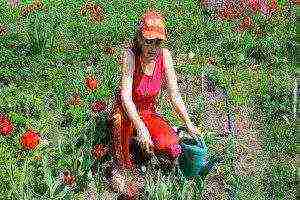 Tulips are plants that love water, but you should not flood the flowers or wait for the soil to dry out completely.
Tulips are plants that love water, but you should not flood the flowers or wait for the soil to dry out completely.
Use warm (about 20 ° C), water that has stood for a couple of days so that it has a minimum chlorine content (if it is tap).
Droplets should not falling on flowers or leaves, this is fraught with the appearance of spots on the petals and wilting of the buds.
Useful advice! Dig grooves between the rows of tulips and pour water there, not directly under the bushes. After soaking up the water, cover the grooves with earth to prevent the moisture from evaporating.
Fertilizers
 Fertilizers are usually applied when planting bulbs, but due to heavy rainfall, useful substances can be washed out of the ground.
Fertilizers are usually applied when planting bulbs, but due to heavy rainfall, useful substances can be washed out of the ground.
To feed tulips, you can also use fertilizers in the spring - it is most convenient to apply them by dissolving in water.
Fertilizer options:
- Mineral fertilizers, which contain nitrogen, potassium, phosphorus. For example, "Kemira Kombi" Nitrofoska, "Flower Paradise", Ammofoska. Fertilizers are applied at the rate of about 20 g / 1 m² land (instructions are attached to each fertilizer);
- Fertilizers organic (necessarily high quality, disinfected from bacteria and microorganisms). "Harmony", "Life-giving force", "Geoplant", etc. The calculation of the amount of fertilizer depends on the fertility of the soil and is 10-50 g / m2.
The appearance of the plant testifies to the lack of one or another mineral substance.
Rapid wilting in a bouquet, fragile stem, small leaves indicate that the tulip needs in nitrogen, solution - top dressing with ammonium nitrate (10-15 g / 1m²).
Small deformed flowers, a bluish tint of the leaves are a sign of a lack of potassium and phosphorus, the solution is feeding with potassium nitrate, superphosphate (30-40 g / 1m²).
Care during and after flowering
During the flowering process, tulips require intensive watering (10 liters of water per 1m²) and the fertilization mentioned earlier.
As often as possible inspect flowering plants - this will help you find flowers affected by diseases and remove them.
You should also get rid of weeds and loosen the soil after each watering so that a dry crust does not appear on it.
After tulips faded, it is not necessary to stop their intensive watering for several weeks - during this period, the active formation of the bulb takes place.
Watering promotes the accumulation of more nutrients. Remove fallen petals immediately so that they do not cause rotting.
You can only cut off the stems when they are completely yellow. By completing this procedure earlier, you will provoke cessation of bulb development.
Transplant features
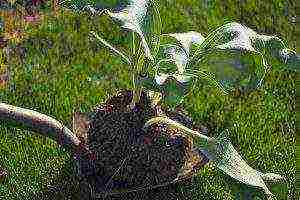 For transplanting tulips it is necessary to dig up the bulbs, observing some rules.
For transplanting tulips it is necessary to dig up the bulbs, observing some rules.
It is best to do the digging in June-Julywhen the soil is crumbly contains a small amount of moisture:
- get out onion from the ground;
- carefully cut or break off leaves and stems;
- remove the old husk Brown;
- rinse healthy bulbs disinfectant (for example, foundation).
The bulbs should be transplanted in the fall - during the normal planting season.
When to dig up the bulbs
 The bulbs are dug out in order to eliminate weakened and diseased plants, to select the largest and healthiest planting material, to prevent the appearance of many small bulbs (unsuitable for planting).
The bulbs are dug out in order to eliminate weakened and diseased plants, to select the largest and healthiest planting material, to prevent the appearance of many small bulbs (unsuitable for planting).
In other words, it is a guarantee of the preservation of the variety and large, healthy, beautiful flowers. Excavation period bulbs depend on the climatic zone (from May to early July).
In order not to be mistaken in the calculations, you should focus on the most important indicator - yellowed leaves tulip. As soon as about 2/3 of the length of the leaf turns yellow, you can safely remove the bulb.
You may be interested in articles on growing and caring for other flower crops.
How
grow gladioli
You will find out by reading this article.
And here is an article about caring for dahlias.
For detailed information on how to grow a tree peony, read our next article.
Reproduction
Seed propagation
The seed method of propagation of tulips is used only to breed new variety of flowersbecause seedlings can bloom 5 years later and later after planting.
In addition, they do not repeat characteristics of the variety - properties characteristic of a certain variety of plants (the size of the buds, their shape and color, the height of the peduncle, etc.).
Tulips are pollinated cross way, as a result of which seed pods appear.
It is important that they are completely ripe, and the box burst spontaneously, after which the seeds can be collected and saved until autumn.
Seeds ready for planting are exposed to low temperatures (from -10 ° С to -20 ° С) for 3-4 monthsso that in the future they germinate at the same time.
Plant development takes place gradually: first, one tubular leaf appears, a root and a stolon (shoot that comes from the base of the plant) with a bulb.
Then the bulb deepens and grows in size. A year later, it takes root, a flat leaf appears, the old bulb dies off and a new one forms - a replacement.
After a couple of years, the bulb has several daughter bulbs, possibly flowering, which should be stopped (it will interfere with the development of the tulip).
Young bulbs can be planted in prepared soil, but the flower will become fully mature on 6-7 years after planting seeds.
Bulb propagation
The tulip has one adult bulb, from which, in the process of development, one substitute and several subsidiaries appear.
To increase the number daughter bulbs, you need to cut the buds during flowering. Then the bulbs are dug up, stored until autumn and planted in the soil in rows.
At the same time, all care rules for the bulbs: watering, fertilizing, loosening the earth, etc. Be sure to destroy blooming flowers.
Complete bulbs can be planted through 3 years (early variety - after 2 years).
Diseases and pests
Fungal diseases:
- Gray rot - quickly spreads in wet weather in the form of yellow-gray spots, affects the aerial parts of the flower and bulb, is treated by spraying plants with a Bordeaux mixture (1%) during the growing season. A medicine is being prepared based on 100-150 ml / 1m²;
- Root rot - partial rotting of the root system, deterioration of the decorative qualities of the tulip, is treated with disinfectants (potassium permanganate, foundation). The medicine is applied when watering at the rate of 10 g / 10 l of water;
- Tifulez - the plant lags behind in growth, the shoots turn red, the buds develop incompletely. It is treated by removing affected plants, timely destruction of weeds, digging up the soil after removing the bulbs.
Viral diseases:
- Variegated - the most common viral infection among lily tulips, which manifests itself as a change in the color of the flower, is not treated, is transmitted through juice, garden tools should be disinfected to prevent the disease;
- August disease - the appearance of strokes on the stems, leaves with their further drying. The bulb becomes spotty, it is treated by removing the diseased plant along with an earthen lump.
Non-communicable diseases:
- "Blind" (pale) buds - a common disease during the forcing period. Forcing is the process of the most active growth and development of a plant. To accelerate the development of a tulip, it is necessary to create the most suitable conditions for it. Prevented by observing planting dates and careful selection of bulbs before planting;
- Peduncle drooping, stem damage... Prevented by observing the temperature regime, adding calcium to the soil before planting;
- Calcareous disease - hardening of the bulbs, a change in their natural color, is prevented by observing the storage conditions, digging the bulbs.

Aphids on a tulip
Pests:
- Root onion mite - affects the bulb, penetrating into the sinuses between its scales, causes rotting. Prevented by treating the bulbs with water (35-40 ° C) before planting and spraying with Actellik poison (according to the instructions) during the growing season;
- Greenhouse aphid - affects leaves, peduncles, stems, as a result of which the organs are deformed. You can destroy the pest by spraying the outer part of the plant with the preparations "Fitoferm", "Inta-Vir" during the growing season, by planting insecticidal plants nearby (they protect plants from pests: dope, calendula, marigolds);
- Onion hoverfly - fly larvae infect the bulb, as a result, the plant stops developing and dies. It is destroyed by removing diseased plants, it is prevented by treating the bulbs with fundozol before planting.
How to store bulbs
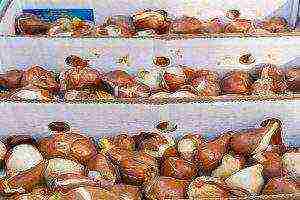 It is important that the bulbs are clean, dry, without leaves, roots, etc..
It is important that the bulbs are clean, dry, without leaves, roots, etc..
It is recommended to decompose them before long-term storage. in boxes for ventilation and leave in the air in the shade for a couple of days.
For long-term storage of bulbs, a place with moderate humidity and temperature (23-25 ° C). The closer to winter, the lower the temperature should be - about 15 ° C at the beginning of autumn.
You can use any room in the house, as long as it is all the time ventilated.
Place the bulbs in the box, spreading them in one layer, sprinkle the planting material with sawdust or wrap each onion in a newspaper.
Inspect them periodically for putrefaction or any other changes, discard the spoiled material immediately.
How to properly dig up and store tulip bulbs more clearly, shown in this video:
Rate the article
Tulips are a luxurious decoration of the spring garden. The flowerbed with them is multicolored and very elegant. Having learned in detail about tulips, planting and care in the open field, you can not be afraid that the plants will not bloom.
Features of growing tulips in the open field

Growing tulips in the open field is quite simple and feasible even for a novice florist. In order for plants to retain their varietal qualities from year to year, they must be dug up annually, dried and planted again. Without this, the flowers are quickly crushed, lose varietal differences, or even die.
Choosing bulbs for planting
The result of the grower's efforts also depends on how correctly the bulbs are chosen. It is better to acquire planting material in the middle of summer or at the end, since during this period the plants are at rest and do not experience stress during planting. In autumn, at the very peak of planting a bulbous flower, it can be more difficult to acquire high-quality planting material. If you buy the bulbs in the spring, they will be old and worn out by winter storage. In the spring, things are sold that were not sold in the fall.
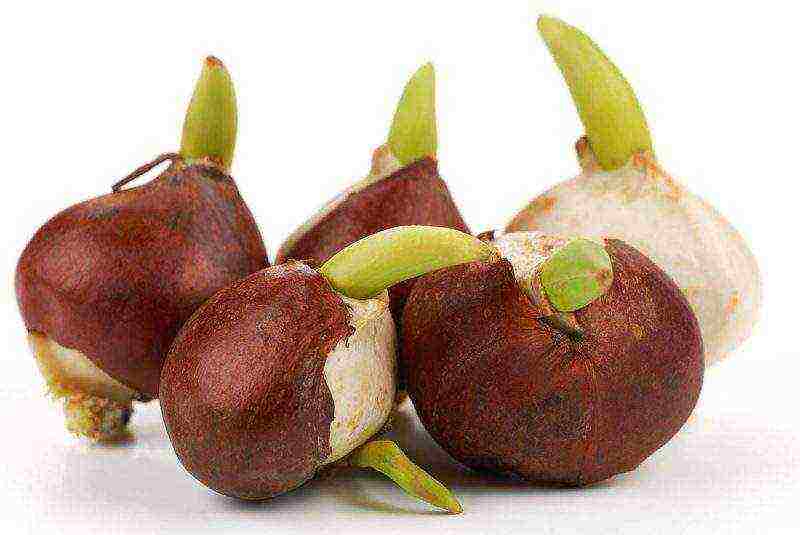
When buying, you should choose those bulbs that have a thin husk of a pleasant golden color. Cracks in the skin are normal.
The onion itself must be whole. If there is damage on it, then the purchase should be abandoned, since in this case it will not be possible to obtain a high-quality plant.
Choose an average size of the purchased onion, and when you take it in your hand, its weight should be felt. When examining the bottom of a good planting material, small root tubercles will be visible. If the bottom is soft, or the roots have already sprouted, you should not buy the bulb.
Time and timing of planting tulips
The homeland of the plant is Central Asia. In natural conditions, tulips bloom intensively in early spring, and after that they dry out and go into a state of dormancy. In gardens, their life cycle follows the same principle. Therefore, it is important to immediately accurately determine the correct planting date, since a mistake in it will lead to the death of the flower.
In autumn
Autumn is the best time to plant tulips. Experienced gardeners only plant bulbs in September and never move the planting time until summer or spring.It is advisable to choose a dry day for work. Details on how to plant tulips in the fall are described in the next section.
If the bulbs are planted too early, they will not only form roots before winter, but also release the aboveground part. As a result, tulips will freeze and may die. If the plant survives after this, then it will definitely not bloom.
Planting too late means that the bulbs do not have time to take root. For this reason, the plant hibernates incorrectly and in the spring, after spending the last strength on rooting, it no longer blooms. Also, tulips unrooted before frost can easily rot or freeze out.
In the event that for some reason it is necessary to plant plants at the end of October or even in November, when they do not have time to take root, the garden should be covered with spruce branches, or mulched with a thick layer of sawdust. Fallen foliage is also suitable for shelter.
In the spring
Spring is not the right time to plant tulips. The bulbs will be able to take root and even bloom in the middle of summer, but their life cycle will be seriously disrupted. Because of this, they will have to be dug out quite late, and, therefore, the autumn planting time will shift to late autumn.
It is best, if tulips are purchased in the spring, to plant them in a container very early - even before the snow melts. After the onset of persistent heat, the plants are planted without removing them from the container, as this will facilitate their further digging.
How to plant tulips correctly?
When planting tulips, correct agricultural technology is of great importance, which allows the plants to be provided with the most comfortable conditions. Violations of it will lead to poor flowering and sometimes even rotting of the bulbs. Planting tulips requires adherence to certain rules.
Soil requirements, site selection
A site for tulips is chosen in the fall after the foliage has fallen from the trees. It should be very well lit. Since tulips will fade before the trees open their leaves, it is not scary if the flower bed is in the shade in summer. For plants, light is important only until the end of flowering. It is better to stir the flower bed out of the blue, where melt water does not accumulate.

Tulips need soil that is neutral or slightly acidic, loose. The fertile layer needs a thick one. High water permeability and air permeability are also of great importance for the plant. Do not plant tulips in areas where bulbous crops or nightshades have previously grown. This is due to the accumulation of pathogens in the soil, which can transfer to flowers.
If the soil is heavy, then frequent loosening will be required. Without this, it is impossible to grow fully blooming tulips.
Landing in open ground
You can plant only healthy bulbs that do not have foci of decay and are not affected by diseases. Before planting, they must be soaked for 30 minutes in a slightly pink solution of manganese. After that, the bulbs are dried for an hour and planted.
It is more convenient to plant bulbs in furrows rather than holes, as this allows you to plant as many tulips as possible. The furrow spacing should be at least 25 cm for easy maintenance of the flowers and the bulbs can grow with enough soil and nutrients. The row spacing between the plants should be 10 cm.
How deep should you plant?

If the soil is light, the planting of the bulbs is deeper than with heavy soil. In the first case, the bulbs are planted at 3 heights, and in the second - at 2 heights. On average, this is 15 cm and 10 cm, respectively. You need to know that rooted bulbs will go even deeper.
Tulip care

In addition to proper planting, tulips also require competent care, which will allow them to gain maximum strength for a particularly beautiful flowering. Despite all their unpretentiousness, varietal plants will not be able to feel good if they are left to themselves.
Watering and feeding
Plant feeding is carried out 3 times in the spring. Without this, the bulbs will not receive enough nutrients and will leave weakened during the rest period. In addition, a lack of feeding will lead to the fact that high-quality buds and large flowers will not form.
- First feeding. Carried out immediately after the tulips have emerged from the ground. Nitrogen fertilizers are used for it.
- Second feeding. Carried out when laying the buds. Complex mineral compositions with a high content of potassium and phosphorus are used for it.
- Third feeding necessary after tulips bloom. Potassium-phosphorus fertilizers are introduced.
Tulips react very positively to wood ash, which can be sprinkled on the soil before watering at any time.
Watering during flowering is very important for tulips. Water is poured at the root.
Usually 2-3 waterings per week are enough. After the flowers have wilted, the soil moisture is stopped so that the bulbs go into a dormant state.
Loosening

Loosen the soil around the tulips regularly after watering. At the same time, weeds are pulled out. If it is not possible to loosen the soil, you can mulch it.
Features of care after flowering
After the tulips have faded, they also need to be cared for. In order for the plant not to waste energy on the formation of seeds, the flowers, after they wilt, are cut off completely. Only leaves are left. The more leaves a plant has, the better.
When to dig up tulip bulbs?
The bulbs are dug out after the aboveground part of the plant has turned yellow. Do not try to pull them out by the stem, as if it breaks off, it will be difficult to remove the bulb. Due to the property of tulips, they will go deeper into the soil at the time of digging up they will be deeper than when planting.
Storage conditions
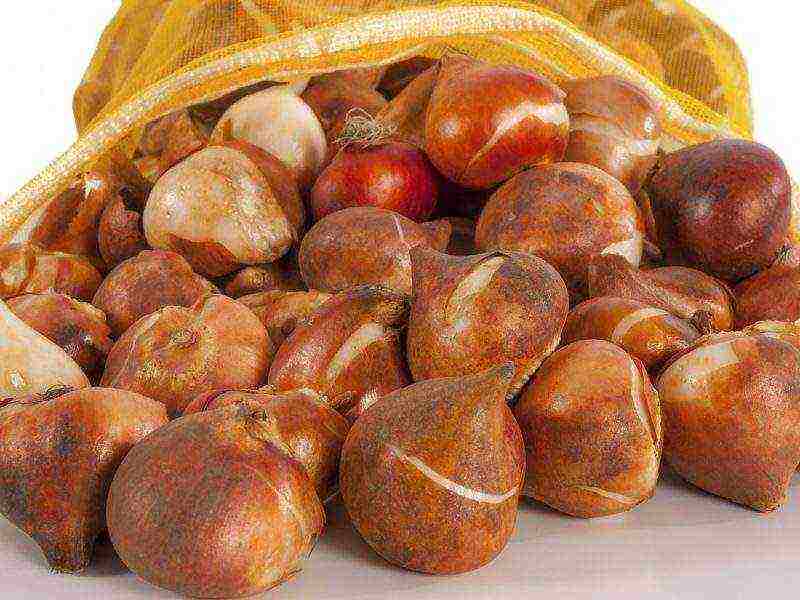
The dug out bulbs are dried in the shade under a canopy or indoors for a month. After that, folded in paper bags, they are removed until the autumn planting. The temperature at the storage location should be between +15 and +18 degrees. If spoiled bulbs are found, they should be discarded. They will not sprout in spring, but they infect the planting site.
Protection against diseases and pests
Whichever tulip variety is chosen, it can be subject to disease and pest attacks. If the plant is affected by fungal diseases, then to save the flower, it is necessary to transplant it to a new place and spill it with a 1% solution of Bordeaux liquid.

Of the pests, the main danger for tulips is:
- bulbous mite;
- slugs;
- snails;
- bear;
- rodents.
Mousetraps and poisoned baits are used to get rid of mice. From pests, special preparations are used that destroy insects and mollusks that attacked the flower.
Growing tulips is a fascinating activity that, due to the variety of varieties, often becomes a real hobby for a grower.

